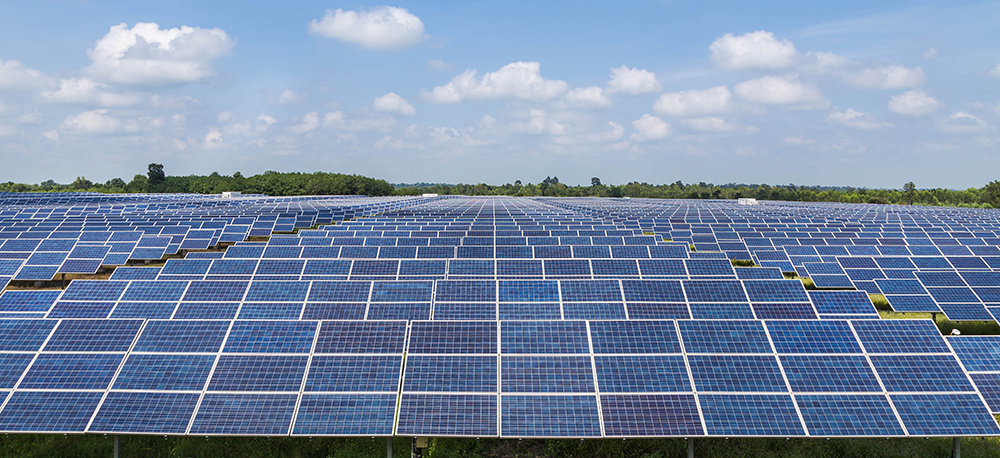Landowner Resources for Grid-Scale Solar
Large solar installations designed to produce power for the grid, often called grid-scale solar, are being developed throughout the Commonwealth. These projects are typically installed on lands leased from PA landowners.
Currently there are over 18 gigawatts (GW) of proposed solar energy in the PJM grid queue, most of which are large scale solar installations. Grid scale solar can be defined as a solar photovoltaic system that participates in the wholesale electrical market and typically produces electricity for sale, not to offset local energy demand. These solar projects are constructed on large, leased parcels of land, and a landowner may have questions about the development process as well as the land lease terms proposed by the developer. The following resources are provided to landowners interested in learning more about leasing land for grid scale solar. Landowners interested in installing solar panels for their own use should check the resources provided on the Residential page.

Leasing your Land
Farmland owners are increasingly being approached by developers looking to lease their land for grid-scale solar projects. Landowners working with developers should investigate local township or government ordinances as they may also have restrictions on land use. Before signing any contract, you should consult with an in-state attorney or a legal professional who can review the proposed lease contract and answer any specific questions you may have. Looking for more information on leases? In order to better understand the solar energy development and land leasing process involved, check out the resources below:
- Penn State Extension Resources for Landowners:
- The Pennsylvania Landowners Guide to Utility-Scale Solar Leasing provides background information on the grid-scale solar development process as well as additional information on the leasing process including the Letter of Intent (LOI), Option Agreements, the Lease Agreement, the Purchase Agreement, and additional considerations that may affect landowners.
- The Landowner Leasing for Utility Scale Solar Farms guide provides information on property evaluation, components of the lease document, and concerns related to those documents as well as other landowner considerations for grid-scale solar leases.
- Additionally, the Penn State Extension has a series of webinars that focus on solar topics such as leasing, land use, and environmental concerns.
- The Pennsylvania Public Utility Commission factsheet provides information for landowners on land lease agreements.
- The Solar Energy Industry Association has a Guide to Land Leases for Solar that walks thru the steps of both the solar lease and development processes, as well as provides a list of questions to ask a solar developer.
- The Pennsylvania Department of Agriculture provides links to various state Farmland Preservation programs that may be important when considering leasing your land to a solar developer. The Clean and Green Program, managed by the Pennsylvania Department of Agriculture may contain restrictions on where solar projects may be sited on your land.
- Ohio State University has created a Farmland Owner’s Guide to Solar Leasing which provides information on lease agreements and considerations when leasing your land for solar.
Commonwealth of Pennsylvania Grid-Scale Solar Siting Policy Statement
A working group of Commonwealth Agencies, including the Departments of Agriculture, Community and Economic Development, Conservation and Natural Resources, Environmental Protection, and General Services developed a Grid-Scale Solar Siting Policy to provide guiding principles to stakeholders, including landowners, solar developers, and municipal governments, to consider when evaluating proposed grid-scale solar projects.
In summary, the Commonwealth seeks to:
- Prioritize reuse and repurposing of previously impacted lands to make these sites viable alternatives for hosting grid-scale solar development compared to greenfield areas such as agricultural and forested lands.
- Balance potential opportunities of grid-scale solar energy projects with priorities and benefits of agricultural preservation and sustainable forest management.
- Support project siting that elevates equitable sharing of environmental, health, social, and economic benefits while advancing the Commonwealth’s environmental and climate justice goals.
- Respect local decision making on the siting of projects within parameters established in existing and informed community-based comprehensive planning efforts.
- Protect landowner interests and safeguard future land uses through informed project planning that includes project decommissioning plans to ensure site restoration following project closure.
The full Grid-Scale Solar Siting Policy can be found here.